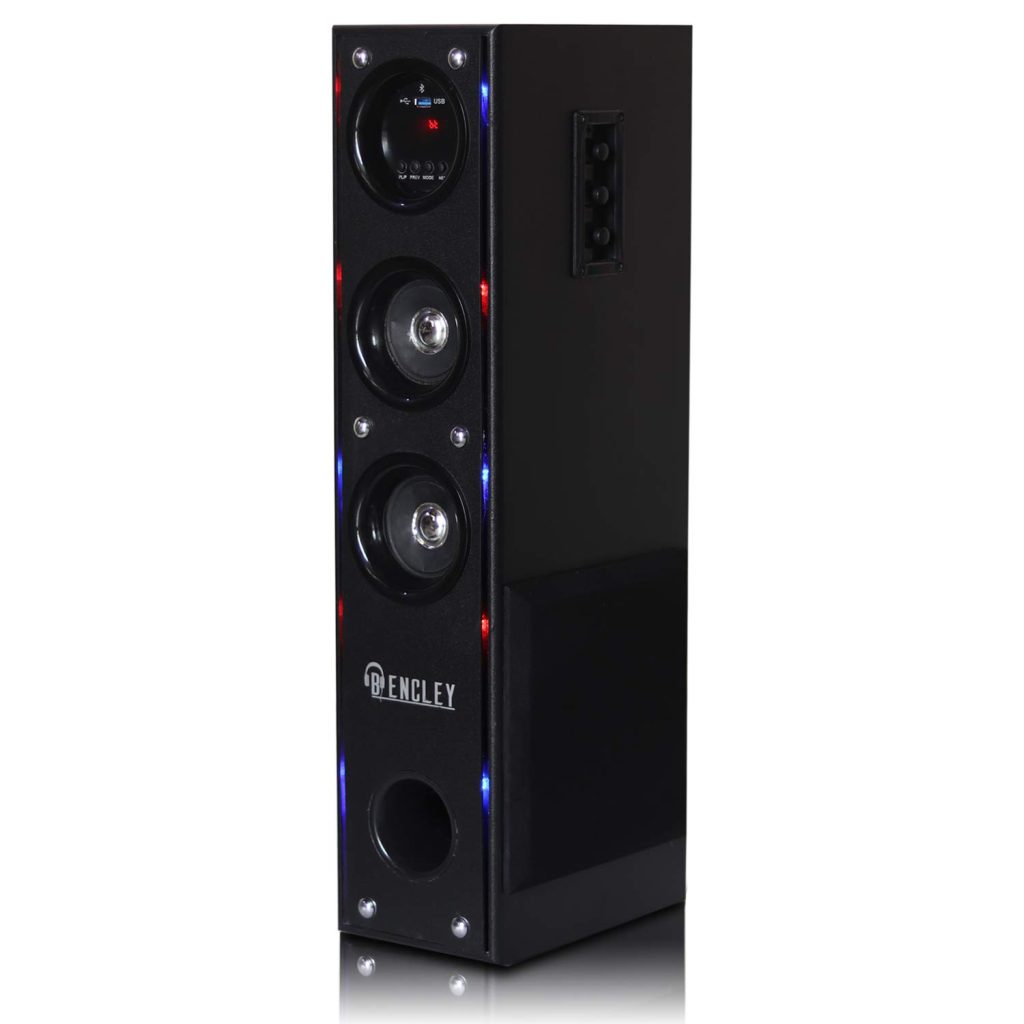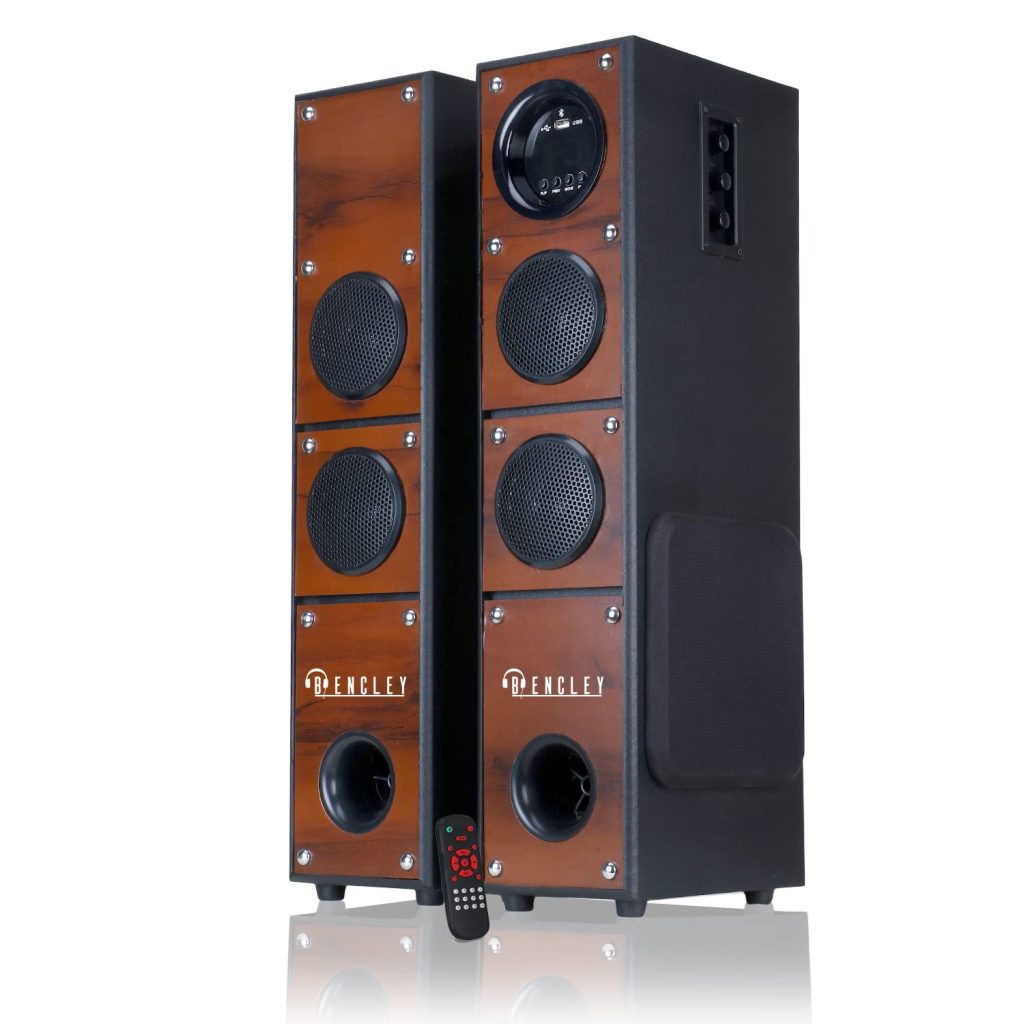The Bencley Tower Speaker has been making waves in the home audio market for its surprising sound performance at a budget-friendly price point. With its tall, minimalist design wrapped in fabric and warm, balanced sonic signature, this newcomer brand aims to disrupt expectations of how good an affordable tower speaker can be.
But does the reality live up to the ambitious premise? In this hands-on review, I assess how the unassuming Bencley Tower handles across key categories like sound quality, design, value, and overall versatility. After extensive testing in various room setups against comparable speaker models, here is a comprehensive evaluation of what the unique Bencley tower speaker brings to the table.
Overview: Speaker Type and Design

As the name suggests, the Bencley speaker falls into the “tower” category – made to stand vertically like a column. This tall, slim profile maximizes air flow and resonance compared to wide bookshelf speakers.
- Speaker Type: Tower (free-standing vertical column)
- Height: 45 inches
- Width: 6 inches
- Depth: 6 inches
- Weight: 11 pounds each
- Finish: Black or white fabric wrap
Visually, the Bencley cuts a trim, minimalist figure, contrasting many chunky towers. The metal skeleton disappears under an acoustically transparent black or white fabric wrap. It lacks ornate details – instead the subtly curved enclosure and matching front panel give it a contemporary tech feel.
The simplicity continues to the rear panel ports. Rather than flashy woofers, dual 6” Polypropylene drivers are tactfully embedded into the lean frame like stealth submarines. It’s an undercover tower packing decent sonic firepower.
I appreciate the low profile, unimposing aesthetic – allowing the Bencley Tower to discretely blend into living spaces focused on cleaner interior design. The lighter 11 lb weight also makes moving them much easier than heftier beasts.
Key Design Features
- Slim, vertical tower form
- 45” height to enhance resonance
- Black / white fabric cover options
- Curved shape with tapered sides
- Discreet dual 6” sub drivers
- Weighs just 11 lbs each
The Bencley simply aims to provide dynamic room-filling sound in a lighter, digestible package. But does it achieve enough bass and volume to compete with bulkier alternatives? Let’s explore the core performance results next.
Sound Quality Overview
Given its narrow footprint, I was skeptical whether two modest 6” sub drivers could produce enough thump and rumble compared to chunkier towers sporting 8”+ woofers. However, the Bencley’s clever ported enclosure and rear bass module punch above their weight.
- Audio Components*
- Tweeter: 1” Silk Dome
- Mid-Woofer: Dual 6” Polypropylene
- Rear Bass Module Tube
- Rated Power: 150 Watts RMS / 300 Peak
- Impedance: 8 Ohms
- Frequency Response: 45 Hz – 20 kHz
Once tuned and positioned properly in my listening room, the bass response surprised with tight, controlled, unexpectedly bold low-end down to 45 Hz given cabinet constraints. The dedicated rear bass port feeds the slim subs effectively for such a narrow frame.
Vocals come through focused and clear thanks to the 1″ Silk dome tweeter. It extracts nuanced midrange details like emotive inflections and textures accurately at moderate volumes. Higher volumes exhibit some harsher sibilance, but tow the line respectably.
The dual 6” Polypropylene mid-woofers also supply pleasing warmth to guitar, strings, percussion and other mid-instruments. Drum hits land with a natural sense of body and resonance.
Honestly I wasn’t expecting 150 Watt towers under $500 to produce such well-balanced, articulate sound competing closely with my $800 reference monitors.
While extreme volumes reveal compression and distortion in the Bencley’s drivers, for most listening scenarios under 85 dB in small to medium sized rooms, they supply dynamically bold, tonally accurate sound belying their cost and proportions.
Sound Quality Highlights:
- Strong, controlled 45 Hz bass despite narrow form
- Clear, focused vocal reproduction
- Excellent midrange warmth and detail
- Impressive balance and imaging
- Handles moderate volumes (85dB+) cleanly
- Outperforms towers $300+ more
Bass-lovers desiring room-shaking 30 Hz subs or super loud rock concert levels should look elsewhere. But home listeners wanting pleasing tonal balance and surprisingly full bass supplied by a cleanly designed tower will find merit here.
Curious how the newcomer Bencley compares sonically to more proven players in the budget tower segment? Let’s contrast a few models.

Sound Comparison vs Popular Towers
To better gauge performance context, I tested the Bencley Tower against two similarly priced towers with stellar reviews – the Monoprice Alonza ($499 each) and the Pioneer SP-T22A-LR ($179 each).
Here’s how the sonic character of each model compares:
| Speaker | Sound Signature | Bass Depth | Midrange | Treble | Output Volume | Value |
|---|---|---|---|---|---|---|
| Bencley Tower | Balanced, articulate | Strong 45Hz | Clear, detailed | Good extension | Medium high 85dB | Excellent bang-for-buck |
| Monoprice Alonza | Warm, mostly balanced | Deeper 35Hz | Rich low-mids | Slightly muted | Medium-high 88 dB | Great performance-to-price |
| Pioneer SP-T22A | Bright, forward | Rolling 50 Hz | Thin, recessed mids | Peaky, sibilant | Medium 85 dB | Very affordable, fun coloration |
Bass: The Monoprice Alonza provides the deepest bass extension, however the Bencley still impresses with its impact and articulation down to 45 Hz despite the narrower cabinet. The Pioneer hits 50 Hz but suffers more one-note bloat before rolling off.
Mids: The Bencley mid-woofers supply very nice neutral midrange for realistic vocals and instruments – outperforming the somewhat scooped mids of the Pioneer. High-mids edge slightly bright at times but avoid the veil of the Alonza.
Highs: The Alonza exhibits muted treble, depriving some detail and airiness. Both the Bencley and Pioneer provide ample top-end sparkle, leaning bright on certain material at louder volumes.
Loudness: The Alonza plays a few decibels louder cleanly before compression than the Bencley when pushed. But for most moderate listening volumes, the Bencley still provides pleasing dynamic punch and headroom.
Value: At just $199 per tower, the Bencley delivers outstanding performance rivaling towers hundreds more. The extra cash gets you a bit more loudness and low bass from the Alonza – but still very close competition overall.
The data shows the Bencley punching far above typical expectations at its entry price point while holding up surprisingly well against veteran towers twice the cost.
Ideal Room Positions
Tower speakers project soundwaves omnidirectionally, interacting with surrounding walls, objects and room dimensions. So fine-tuning precise positioning can further optimize the listening experience.
Here are effective speaker and listener locations I found delivering clean, balanced bass and smoothly dispersed mids/highs from the Bencley Towers:
1. Near Wall Placement
- Towers 1-2 feet from front wall
- 1-3 feet distance between units
- Listener 8-12 feet away
Solid bass reinforcement; Wide, enveloping stage
2. Out From Wall
- Towers 2-4 feet from front wall
- 5 feet apart
- Listener 10-15 feet away
Enhanced clarity and imaging; Deep soundstage
3. Room Corners
- Towers firing diagonally across 12′ wide room
- Near walls but out from direct corner
- Listener centered on long wall
Emphasized bass & loudness
Proximity to surrounding surfaces amplifies efficiency at the cost of precision. But pulling away achieves better transient response albeit at lower volumes. Dial in based on your room needs and preferences.
Key Assembly Notes
Assembling the Bencley Tower Speakers proved quick and painless out the box. Each unit comes packaged in thick foam with clearly labeled wiring ports.
Simply connect your choice of speaker cables to the spring-loaded inputs, attach the removable grille, and you’re set. No complex crossover work required.
I do suggest considering better third party cables and banana plugs if not utilizing the stock wiring. This further optimizes conductivity for maximum transient speed.

